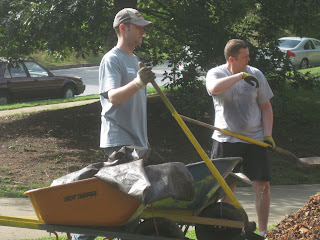Lets start with the big news: we made it through the summer!
In spite of weeks of drought most of our native plans managed to survive and that, in part, due to Dorothy Dabbs, Jane Merkle and Knapp Wilkins, jug handlers extradinaire, who helped to water the garden.
Many of our natives are beginning to thrive as they reach maturity. Our winterberries have, yes, bright red berries on them, a feast for Northern Mockingbirds, American Robins, Gray Catbirds and Cedar Waxwings. The pink Gaura are blooming and tempting lots of bees and other bugs. We have several goldenrod plants in the process of blooming. The first of these bloomers is the Golden Fleece Goldenrod whose sprays of small yellow flowers attract butterflies and bugs as well as the hummers who fly in to slurp up a dinner of those unsuspecting bugs. The Obedient Plants have lovely violet blooms this year, and are obediently seducing butterflies and bumblebees.
 |
| Ruby-throated Hummingbird |
The Ruby-throated Hummingbird (Archilochus colubris) did a fly-by at the garden on August 6th, a first for us. Thanks to Tom Blakely, for the ID. Tom’s own Lake Claire yard, BTW, has been certified as an Audubon Wildlife Habitat. Donna Latham and I recently put up a hummingbird feeder in the garden hoping for more of them during this migration period.
A little more about hummers: The Ruby-Throated is the only hummer native to Georgia and the Eastern United States. Hummingbirds species, like Wild Turkeys, are true natives, only found in the Americans. Imagine the amazement of the first European settlers at the small size of the birds as well as their flying abilities: they fly backward, forward, up and down, and side to side, as well as stand still in midair.
According to June Osborne in
The Ruby-throated Hummingbird, the Taino people of the Bahamas (the first tribe encountered by Christopher Columbus in the New World) called the little bird "sky spirit," "magic sky bird," "god bird," or "sun god bird."
Native Americans used real hummingbirds as ear adornments to signify a person's importance. The bird’s iridescent feathers were considered so beautiful that they were to be flaunted. Rubythroat skins were revered and were exclusively reserved for the tribal leaders. In Mexico, the Aztec war god was recognized by the bracelet of dazzling hummingbird feathers on his left wrist. Members of Aztec royal families wore cloaks of glittering hummingbird feathers.
But let us not feel superior to the peoples of the past, thinking them primitive in their choices. Later, in the nineteenth century, rubythroat skins, as well as those of other hummingbirds, were in high demand to be used as decorations on women's hats, bags, jewelry, fans and gowns in Europe and in the New World.
Hummingbird migration should be over by November 1st. If you see one after that date please notify the Georgia Hummer Hotline at 770 784 1636. And think about keeping your feeders up all winter. You may be lucky and attract a wandering western species.

We also recently hosted a Pearl Crescent Butterfly (Phyciodes tharos), a butterfly found over most of the country (Photo right). Thanks to Malcolm Hodges for the definitive ID. This butterfly prefers any open area, where most of its host plants can be found. Its favorite host (or hostess) is the aster, where the adult butterfly can find nectar and the caterpillar can munch the leaves. Its overall pattern is orange with dark brown, almost black, markings, but that pattern is very variable over the species. The pattern can also can vary from place to place and from season to season. This species has several broods throughout the year, from April–November in the north, and throughout the year in the Deep South. It over winters as an adult in warmer climes and as a caterpillar in cooler places.
My co-coordinator, Phil Edwards, DeKalb Master Gardener Association, has been busy putting in new plants in the butterfly area. Among them, he’s planted 3 Butterfly Weeds, (Asclepias tuberosa), members of the milkweed family (Photo below). The flowers of the Butterfly Weed are a nectar source for many butterflies, bees and other insects as well as for the Ruby-throated Hummingbird. Monarch butterflies depend on this plant for their entire life cycle, from caterpillar to adult. Butterfly Weed needs to be distinguished from Butterfly Bush (Buddleia davidii). The former is a native plant, the latter an introduced species which is of little use to Monarchs.

Butterfly Weed has a bright yellow or orange bloom from June through August. Some species bloom even later. It’s a drought tolerant plant and likes full sun and dry soil. It’s the only milkweed with alternate leaves. Its seed pods burst open in the fall and the seeds gradually fly away on their silky parachutes. Like most milkweeds the juice is milky white.
Butterfly Weed was called pleurisy root in the past in reference to a prior medicinal use of the plant roots to treat lung inflammations. The pods of milkweeds may be eaten if boiled twice discarding the first water to remove the bitter taste. Wow, doesn’t that sound yummy.
Well, its fall so can winter be far behind? We do have some tasks ahead of us and if we accomplish them I’ll be sure to tell. We will be putting in some new plants later in the fall and can always use some help to do so……if you’d like to volunteer at the garden please email me at cvanderschaaf@bellsouth.net We'd love to have you!
Carol Vanderschaaf
Freedom Park Bird and Butterfly Garden
Atlanta Audubon Society
.JPG)
















